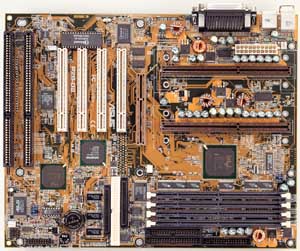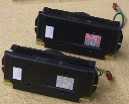Asus P2B-DS
 Abit BP6
Abit BP6
EPoX KP6-BS
Shuttle HOT-649A
Tyan S1832DL
Tech Talk
Dual Celeron
UDMA66 vs SCSI
Intel CPU Fan Hack
LVS SCSI
CPU Core Temp.
 |
|||||||||||||||||||||||
Asus P2B-DSServer class motherboard with a price tag.by Derek Kwan
 Asus P2B (News flash! P3B-F info here)
series motherboard is one of the most famous motherboard in the market. P2B series motherboard is based on Intel's
440BX chipset design. P2B comes with many favours, for example, P2B-D is Dual Slot 1 board, P2B-L comes with onboard LAN
adapter. P2B-DS is a Dual Slot 1 motherboard with onboard Adaptec AIC 7890 & 3860 Ultra2 Wide SCSI controller
and it supports up to 15 devices and 80MB/s transfer rate. One component worth mentioning about this motherboard is that, in
all our samples, only this board seems to have memory buffer chip installed on the motherboard.
while also noticing on the motherboard, is seems like Asus might have a plan to support
Adaptec's RAIDport III connector on one of the PCI slot. (What uses RAIDport III
connector? Check out Adaptec's ARO-1130U2 Ultra2 RAID CARD.) Asus P2B (News flash! P3B-F info here)
series motherboard is one of the most famous motherboard in the market. P2B series motherboard is based on Intel's
440BX chipset design. P2B comes with many favours, for example, P2B-D is Dual Slot 1 board, P2B-L comes with onboard LAN
adapter. P2B-DS is a Dual Slot 1 motherboard with onboard Adaptec AIC 7890 & 3860 Ultra2 Wide SCSI controller
and it supports up to 15 devices and 80MB/s transfer rate. One component worth mentioning about this motherboard is that, in
all our samples, only this board seems to have memory buffer chip installed on the motherboard.
while also noticing on the motherboard, is seems like Asus might have a plan to support
Adaptec's RAIDport III connector on one of the PCI slot. (What uses RAIDport III
connector? Check out Adaptec's ARO-1130U2 Ultra2 RAID CARD.)
This motherboard comes with all standard features like 2X (133MHz sideband) AGP (Accelerated Graphics Port), Four 168-pin DIMM supports up to 1GB of PC100 SDRAM, WOL (Wake On LAN) connector, Dual UDMA/33 ports etc.
Like all P2B series motherboard, CPU Core Frequency Multipler and Bus Frequency selection are done via jumper setting. Personally I like jumper setting better than soft menu, atleast you can sure what frequency your CPU is running (see Tyan Tiger 100 review), and if it doesn't boot, it is less painful to restore the settings. We have tested this board with a pair of PPGA Celeron 366MHz Processors on MSI 6905 Ver 1.1 slockets. With BIOS Ver.1008B, P2B-DS detected 2 Celeron Processors correctly at 66MHz, 75MHz and 83MHz FSB. But with 100MHz even at 2.4V VCCCORE it only pass POST (Power On Self Test) but no luck in starting NT Loader.
For higher FSB we think it is possible via some undocumented jumper setting or using SoftFSB, but due to limited time, we do not have any opportunity to expore this motherboard futher. Afterall, Asus P2B-DS motherboard is a pretty solid, reliable and has a very good track record motherboard, if you have extra cash laying around, this is the motherboard you want to buy. This motherboard you will most likely find it in a company's server rather than someone's desk....
Overall Score:
|


